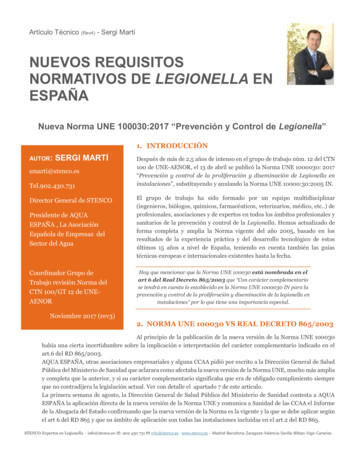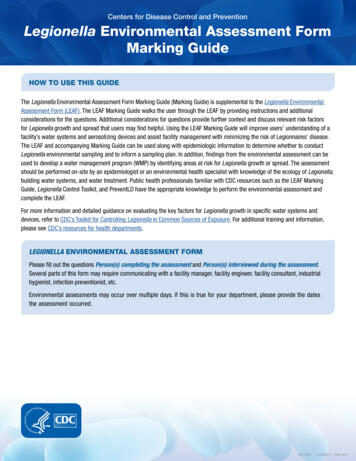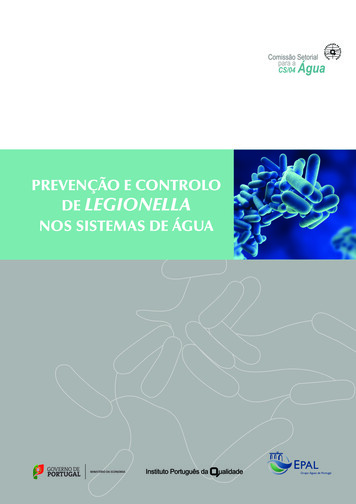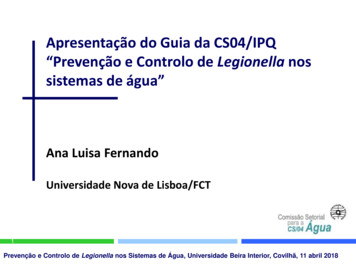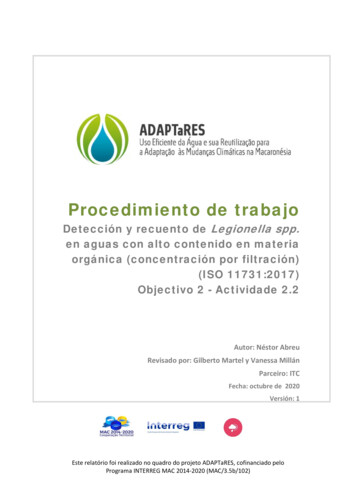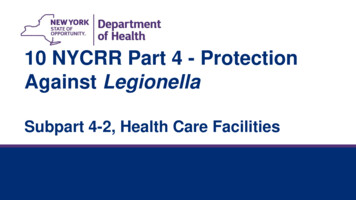
Transcription
10 NYCRR Part 4 - ProtectionAgainst LegionellaSubpart 4-2, Health Care Facilities
2Today’s Presentation Brief overview of Legionella and Legionnaires’ disease Clinical guidelines Infection prevention and control guidelines Part 4 regulatory requirements– Subpart 4-2: Healthcare Facilities Some guidance for Subpart 4-2
3Legionellosis A bacterial infection causing:– Legionnaires’ disease Progressive pneumonia 2-10 day incubation period– Pontiac Fever Self-limiting, flu-like illness (no pneumonia) 1-2 day incubation period– Rarely, can infect other sites
4Legionella Ubiquitous, aquatic organism First isolated in the labin 1943 Facultative intracellularparasite
5Legionnaires’ Disease (LD) American Legionconvention inPhiladelphia, 1976– 200 ill– 20 deaths– Illness linked to hotelair conditioning system
6Epidemiology L. pneumophila causes 90% of infections– Serogroup 1 most common cause of disease– Serogroups 2-6 also can cause disease L. micdadei, L. bozemanii, L. dumoffii,L. longbeachii, L. anisa also causehuman disease
7Epidemiology Legionella prefers aquatic environments– Ideal growth at 77-115 F (25 - 46 C) LD cases have been linked to:––––––Potable water systemsCooling towersShowers/faucetsHot tubs, whirlpool spasRespiratory therapy equipmentRoom-air humidifiers
8Epidemiology Human host factors– Greatest risk group: Immunosuppression Organ transplant, hematologic malignancies, end-stage renal disease– Moderate risk group: Other factors Diabetes mellitusChronic lung diseaseNon-hematologic malignanciesHIVElderly ( 50 years)Tobacco smoking– Rare among children
9Clinical Considerations LD is not clinically distinguishable frompneumonia caused by other agents– Incubation period 2-10 days– Pneumonia developing 48 hours after admissionis considered healthcare facility-associated– Maintain heightened awareness in all healthcarefacility-associated pneumonia, especially personsat greatest or moderate risk
10Clinical Considerations Diagnostic work up should includethe following:– Chest radiograph– Respiratory cultures for Legionella spp. Requires special laboratory techniques; routine sputumculture will not grow Legionella spp. Alert lab that Legionella is suspected!– Legionella urinary antigen test (UAT) Not reliable for serogroups other than L. pneumophila 1
11Clinical Considerations Additional lab testing– Direct fluorescent antibody (DFA) staining– Polymerase chain reaction (PCR) Identifies both living and dead organisms Presents challenge in diagnosis and comparison of clinicaland environmental isolates– Serology Requires acute and convalescent phase sera2-4 weeks apart Not helpful in a timely manner
12Clinical guidelines When isolates are positive forLegionella spp.:– Submit to NYSDOH Wadsworth Laboratories Facilities within NYC should submit toNYCDOHMH Public Health Laboratory– Notify infection control within the facility
13Infection Control Close collaboration with multidisciplinary teamis essential––––––Infection controlPhysical facilities managementEngineeringCliniciansLaboratoryHospital Management
14Infection Control Residents at greatest or moderate riskshould be tested for Legionella if theydevelop a healthcarefacility-associated pneumonia Report all community- and healthcarefacility-associated cases to public healthwithin 24 hours of diagnosis
15Infection Control Respiratory devices/equipment– Use sterile water for rinsing orfilling reservoirs– If reusable, follow manufacturerinstructions for cleaningand disinfection– This includes patient equipmentbrought from home
16Infection Control Guidelines for “protective environments”are outlined in the NYSDOH documentreleased 8/10/15– Does not apply to most nursing homes– Pertain to protecting patients with stem celland solid organ transplants from exposure topotentially contaminated water
17Infection Control If single or multiple cases of LD detected– Report to NYSDOH and localhealth department NYSDOH will provide consultation Investigations in NYC conducted jointlywith NYCDOHMH
18Surveillance Investigations of one or more healthcare facilityassociated cases might involve:– Retrospective and prospective surveillancefor additional cases– Review of facility’s potable water and cooling systems– Molecular analysis of clinical and environmental cultures– Reinforcement of published prevention guidelines– Tap water restrictions for immunocompromised residents– Resident notification
19Regulatory BackgroundWhy is it important to regulate Legionella?Water in the home, workplace, healthcare facilities, or aerosol-producingdevices in public places can be potential sources of exposure to Legionella.––Cooling towers (Subpart 4-1): Proper maintenance of cooling towers is needed to preventthe growth and dissemination of Legionella.Healthcare facilities (Subpart 4-2): Patient surveillance along with the proper monitoring forLegionella in the potable water systems at general hospitals and residential health carefacilities can also help decrease patient exposures and illness.
20CDC DataPercentage of Outbreaks and Cases of Legionnaires’ Disease, by EnvironmentalSource – North America, 2000-2014
21DefinitionsCovered Facilities General hospitalsResidential healthcare facilitiesDefined in Article 28 of Public Health LawPotable Water System A building water distribution systemProvides water intended for human contact or consumption
22Regarding Article 28 FacilitiesIn accordance with the definitions of “general hospital” and “residentialhealthcare facility” set forth in section 2801 of the Public Health Law, 10NYCRR Subpart 4-2 applies to: Buildings of general hospitals that provide in-patient services or tobuildings of residential healthcare facilities providing a “healthrelated service,” such as lodging, board, and physical care. 10 NYCRR Subpart 4-2 does not apply to administrative buildings ofsuch facilities, general hospital buildings that only provide outpatient services, or to diagnostic and treatment centers providingonly out-patient services.
23Environmental Assessment All covered facilities must perform or update an environmental assessmentby September 1 of each yearThe environmental assessment must be updated annually or under certainconditions including completion of construction or repair activities that mayaffect the potable water systemThe Environmental Assessment Form (EAF) is posted on the HealthCommerce System (HCS) and can also be found on the Department’swebsite at: http://www.health.ny.gov/forms/doh-5222.pdf
24EnvironmentalAssessmentForm
25Sampling and Management PlanImplementation and Updating Plans for covered facilities should have been implemented by December 1,2016New facilities must adopt a plan prior to providing servicesThe plan must be updated annually and following specific conditionsRequirements Routine Legionella culture sampling and analysis at intervals not to exceed 90days for the first year and annually thereafter (with the exception ofhematopoietic stem cell transplant or solid organ transplant patient units)Provisions for non-routine sampling for Legionella culture sampling and analysisfollowing disease, construction, and other conditionsCulture analysis by a NYS ELAP-approved laboratory
26Expected Elements –Sampling and Management Plan (S&MP)Additional elements of the S&MP include detailsregarding, for example:––––––Facility informationPersonnel roles and responsibilitiesDescription of the building water systemMonitoring / Environmental culture samplingResponse to 30% Legionella culture resultsPreventative measures
27Legionella Culture Results (Appendix 4-B) 30% of Legionella test sites positive– Maintain environmental assessment and Legionellamonitoring 30% of Legionella test sites positive– Immediately institute short-term control measures– Resample in 1 to 4 weeks– For persistent results, implement long-term controlmeasures
28Health Advisory Guidance – Attachment 3August 10, 2015Guidance on environmental sampling is providedin Attachment 3 of the Advisory: At least 10 sites (taps/showers) are recommended inhospitals with 500 beds; 2 sites per 100 beds isrecommended for facilities with 500 beds. During outbreaks the number of samples would likely beincreased
29Health Advisory Guidance – Attachment 3August 10, 2015The recommended sampling sites should include but not be limited to: One water sample of the inlet of the heating system(s)One water sample of the outlet of the heating system(s)One sample of the inlet of the cold water supplyFloors that housed ill patients/residents, as well as additional floors, shouldbe sampled. Samples should be collected from each floor. This is normallydone in the following fashion:– Tap closest to first delivery of hot water from the riser– One sample from the middle of the system– One sample from the last outlet before the water returns to heaters
30Additional ProvisionsRecordkeeping The EAF, sampling and management plan, and sampling results shall be retained onsite for three yearsEnforcement The Department may conduct an assessment or Legionella culture sampling of thepotable water system at any timeVariances and Waivers A facility may submit a written application to the Department for a variance from anyprovision, for a period not to exceed 90 daysThe Department may issue a written general or specific waiver, where theDepartment is satisfied that such a waiver will not present a danger to public health
31Questions?EnvironmentalClinical Subpart 4-1: ICP@health.ny.govCooling.tower@health.ny.gov Subpart 4-2:HCF.legionella@health.ny.gov Phone: (518) 402-7650 Phone: (518) 474-1142
19 Regulatory Background Why is it important to regulate Legionella? Water in the home, workplace, healthcare facilities, or aerosol-producing devices in public places can be potential sources of exposure to Legionella. - Cooling towers (Subpart 4-1): Proper maintenance of cooling towers is needed to prevent the growth and dissemination of Legionella.

